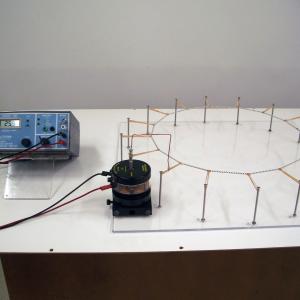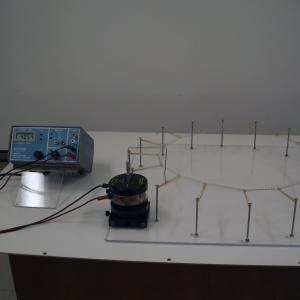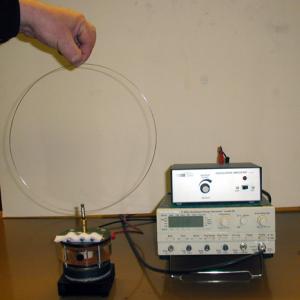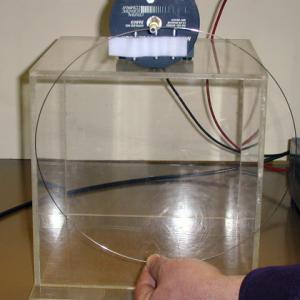College of Liberal Arts & Sciences
7A50.40 - Bohr Model - Vibrating Circular Wire
Clamp the mechanical vibrator body to the Bohr atom board. Use a pair of pliers to then clamp the vibrator wire to the middle of the nearest rubber band. It will be necessary to attach new size 32 rubber bands before use. Approximate frequencies are:
N=1 - 31.75 Hz.
N=2 - 41.4 Hz.
N=3 - 55.6 Hz.
N=4 - 68.5 Hz.
To enhance the viewing of the vibrations, position the blacklights above the vibrating apparatus. The string has been painted with some green fluorescent paint and will show up quite nicely in a darkened room.
When set up, the Pasco wire loop apparatus gives preferred modes of oscillation that are not even integer wavelengths. This makes it necessary to pin the loop at a position 180 degrees from the oscillation points. 1, 2, and 3, wavelengths are then easily seen. Approximate generator frequencies for the wavelengths should be:
1 wavelength = 22 Hz.
2 wavelengths = 65 Hz.
3 wavelengths = 134 Hz.
4 wavelengths = 228 Hz.
The Pasco wire loop is very stiff and will not show vibrations above 3 wavelengths very well. Higher wavelengths can be made more visible by making a wire loop from softer wire.
- Kenneth W. Ford, "Niels Bohr's First 1913 Paper: Still Relevant, Still Exciting, Still Puzzling", TPT, Vol. 56, #8, Nov. 2018, p. 500.
- Peter Riggs, "Revisiting Standing Waves on a Circular Path", TPT, Vol. 59, #2, Feb. 2021, p. 100.
- Erlend H. Graf, "Rubber Band Bohr Wave Functions", TPT, Vol. 62, #5, May 2009, p. 310.
- Danning Bloom and Dan W. Bloom, "Vibrating Wire Loop and the Bohr Model", TPT, Vol. 41, #5, May 2003, p. 292.
- Michael J. Bernstein, "Waves from the Lumberyard", TPT, Vol. 12, #6, Sept. 1974, p. 366, reprinted Vol. 41, #6, Sept. 2003, p. 369.
- Y. K. Vijay, "Mechanical Oscillations in a Circular Loop", AJP, Vol. 64, #8, Aug. 1996, p. 1077.
- L. W. Casperson and M-A. Nicolet, "Vibrations of a Circular Membrane", AJP, Vol. 36, #8, Aug. 1968, p. 669.
- H. F. Meiners, "Standing Waves in a Circle", AJP, Vol. 33, #10, Oct. 1965, p. xiv, also Apparatus Notes, July 1965-December 1972, p. 8.
- "S-105: Standing Electron Waves Demonstration", DICK and RAE Physics Demo Notebook.
Disclaimer: These demonstrations are provided only for illustrative use by persons affiliated with The University of Iowa and only under the direction of a trained instructor or physicist. The University of Iowa is not responsible for demonstrations performed by those using their own equipment or who choose to use this reference material for their own purpose. The demonstrations included here are within the public domain and can be found in materials contained in libraries, bookstores, and through electronic sources. Performing all or any portion of any of these demonstrations, with or without revisions not depicted here entails inherent risks. These risks include, without limitation, bodily injury (and possibly death), including risks to health that may be temporary or permanent and that may exacerbate a pre-existing medical condition; and property loss or damage. Anyone performing any part of these demonstrations, even with revisions, knowingly and voluntarily assumes all risks associated with them.



